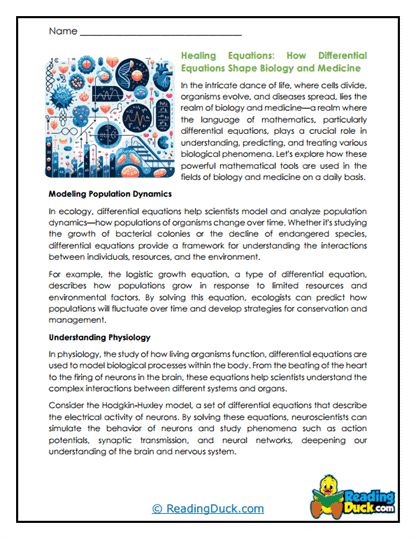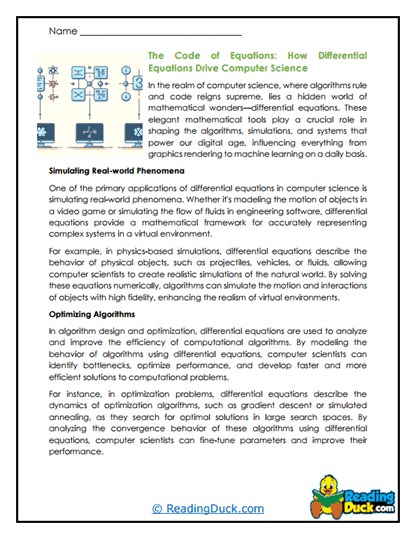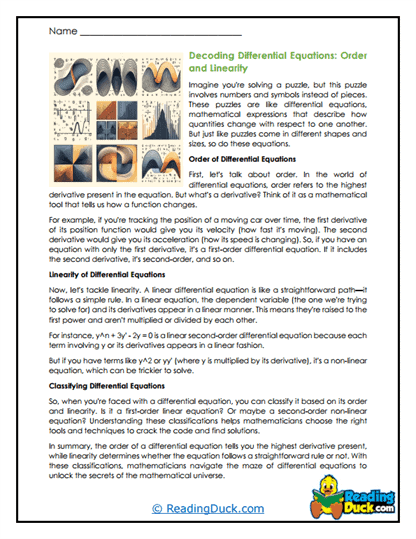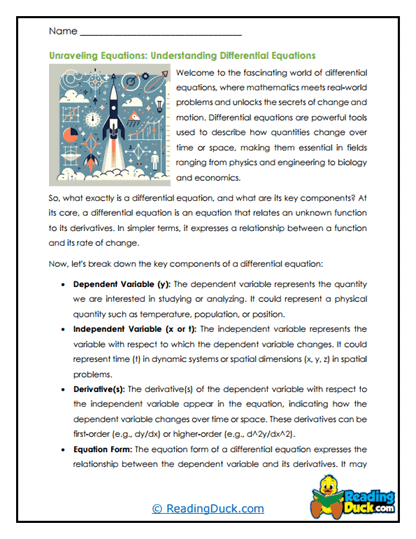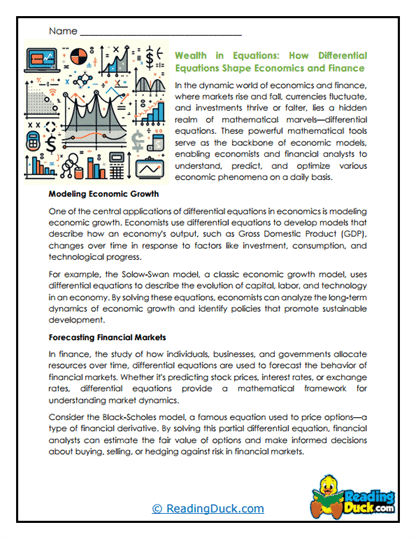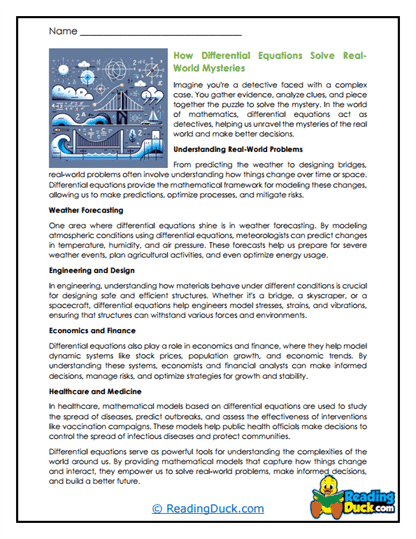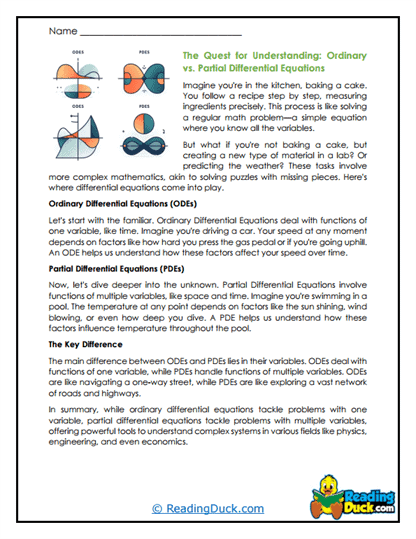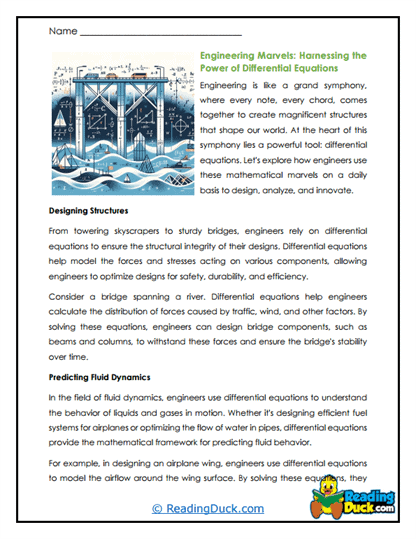Differential Equations Worksheets
About Our Differential Equations Worksheets
Our Differential Equations worksheets offer a comprehensive and engaging exploration of one of the most important topics in advanced mathematics. These worksheets are designed to guide students through the fundamental concepts and techniques used to solve differential equations, making them an essential resource for any math curriculum focused on higher-level math.
Each category within our Differential Equations collection contains several worksheet sets, each focusing on a specific aspect of the topic. These sets are carefully structured to build students' understanding progressively, ensuring they grasp the key concepts before moving on to more complex applications. Each worksheet set includes:
- Multiple Choice Questions: These questions test students’ understanding of the core concepts in differential equations, such as solving first-order and second-order equations, interpreting slope fields, and applying initial conditions. This format helps students reinforce their knowledge and practice problem-solving strategies.
- Short Answer Questions: This format challenges students to work through problems methodically, explaining their reasoning and steps in solving differential equations. These questions encourage critical thinking and deeper comprehension of the subject matter.
- Open-Ended Questions: These questions invite students to explore differential equations creatively and apply their knowledge to real-world scenarios. By engaging with open-ended problems, students can develop a deeper connection to the material and gain confidence in their ability to tackle complex mathematical challenges.
Each worksheet set is designed to assess students’ understanding while enhancing their connection to the material. An answer key is provided for every question sheet, ensuring that educators can easily review students’ progress. All worksheets are available as PDF files, which can be easily viewed electronically, downloaded, and printed.
Understanding Differential Equations: The Mathematics of Change and Dynamics
When introducing Differential Equations to students, it’s important to emphasize that this branch of mathematics is fundamentally about understanding how quantities change over time and how various systems evolve. Differential equations provide the tools to describe and analyze dynamic processes, making them essential in fields ranging from physics and engineering to biology and economics.
Key Aspects of Differential Equations:
- First-Order Differential Equations: First-order differential equations involve the relationship between a function and its first derivative. These are the simplest type of differential equations and often describe basic processes like exponential growth and decay, cooling laws, or simple population models. Understanding how to solve and interpret these equations is foundational for further study.
- Second-Order Differential Equations: These equations involve the second derivative of a function and are used to model more complex systems such as oscillations, mechanical vibrations, and electrical circuits. Students learn techniques like the method of undetermined coefficients and variation of parameters to solve these equations.
- Linear vs. Nonlinear Differential Equations: A key distinction in differential equations is between linear and nonlinear equations. Linear differential equations are generally easier to solve and have well-understood solutions. Nonlinear differential equations, on the other hand, can model more complex and chaotic systems, often requiring numerical methods or approximation techniques for their solutions.
- Systems of Differential Equations: Many real-world problems involve multiple quantities that change over time and influence each other. Systems of differential equations are used to model these interactions, such as predator-prey relationships in biology or interconnected electrical circuits in engineering.
- Laplace Transforms and Fourier Series: Advanced techniques like Laplace transforms and Fourier series are powerful tools in solving differential equations, particularly in engineering and physics. These methods allow students to convert complex differential equations into simpler algebraic forms, making them easier to solve and analyze.
- Applications of Differential Equations: Beyond the theoretical aspects, differential equations are highly practical tools used to solve real-world problems. They are used to model and predict the behavior of systems in physics, chemistry, biology, economics, and engineering. Understanding these applications helps students see the relevance of differential equations in everyday life and various professional fields.
By understanding these key aspects of differential equations, students can build a strong mathematical foundation that will support their studies in other advanced areas of math, science, and engineering. Differential equations are not just about solving abstract problems; they are about understanding the dynamics of the world around us and using mathematics to describe how systems change and evolve.
Examples of Real-World Applications
Differential equations are not just theoretical constructs—they are used extensively in various fields to solve complex problems and model dynamic systems. Here are some real-world applications of differential equations that highlight their importance:
- Physics and Engineering: Differential equations are fundamental in physics and engineering, where they are used to model everything from the motion of planets and the flow of fluids to the behavior of electrical circuits and the dynamics of mechanical systems. For example, Newton's second law, which relates force, mass, and acceleration, is a differential equation.
- Biology and Ecology: In biology, differential equations are used to model population dynamics, the spread of diseases, and the interactions between species in an ecosystem. These models help biologists understand and predict changes in populations and the impact of environmental factors.
- Economics and Finance: Differential equations are used in economics to model the behavior of markets, the growth of investments, and the dynamics of supply and demand. In finance, they are used to model the pricing of options and other financial derivatives, helping investors make informed decisions.
- Chemistry: In chemistry, differential equations are used to model reaction rates and the diffusion of substances. For example, the rate at which a chemical reaction occurs can be described by a differential equation that takes into account the concentration of reactants and temperature.
- Medicine: Differential equations are used in medicine to model the spread of diseases, the growth of tumors, and the response of the body to drugs. These models are crucial for understanding how diseases progress and how treatments can be optimized.
- Environmental Science: In environmental science, differential equations are used to model the flow of pollutants, the spread of contaminants in groundwater, and the impact of human activities on ecosystems. These models help scientists predict environmental changes and develop strategies for sustainability.
These examples show that differential equations are powerful tools that impact many aspects of our lives. They enable us to understand complex systems, make predictions, and develop technologies that improve our world.
Using These Worksheets in Class
To maximize the effectiveness of our Differential Equations worksheets, teachers and parents can incorporate them into their lessons in a variety of productive and creative ways. Here are some tips for using these worksheets in the classroom or homeschool setting:
Contextual Learning:
- Relate to Real-World Applications: Whenever possible, connect differential equations concepts to real-world scenarios that are relevant to students’ interests or future careers. For example, when teaching first-order differential equations, discuss how they are used to model population growth or radioactive decay. Making these connections helps students see the value of differential equations in their everyday lives.
- Apply to Problem-Solving: Use the worksheets to introduce complex, real-world problems that require differential equations to solve. This approach not only reinforces students’ understanding but also challenges them to think critically and apply their knowledge in practical ways.
Promote Collaborative Learning:
- Group Work: Assign worksheets as group activities where students can collaborate to solve differential equations problems and discuss their approaches. Group work encourages students to share ideas, clarify their understanding, and learn from one another, fostering a deeper comprehension of the material.
- Peer Teaching: Encourage students who grasp certain differential equations concepts quickly to help their peers who might be struggling. Peer teaching can be a powerful way for students to reinforce their own understanding while helping others.
Incorporate Technology:
- Use Differential Equations Software: If students have access to computers or tablets, complement the worksheets with software or online tools that can solve differential equations numerically. These digital resources can provide interactive ways for students to explore different scenarios, visualize solutions, and reinforce their understanding of differential equations.
- Virtual Learning: In a homeschool or remote learning setting, use virtual classrooms or online platforms to assign and review the worksheets. This allows for immediate feedback and interactive discussion, making the learning experience more dynamic.
Create a Positive Learning Environment:
- Celebrate Achievements: Regularly acknowledge and celebrate students’ progress as they work through the differential equations worksheets. Whether through verbal praise, digital badges, or a progress chart, recognizing their efforts can boost motivation and confidence.
- Encourage a Growth Mindset: Promote a growth mindset by reminding students that making mistakes is a natural part of the learning process. Encourage them to view challenges as opportunities to grow and develop their skills in differential equations.
Adapt to Individual Learning Needs:
- Differentiated Instruction: Use the variety of worksheets to differentiate instruction based on students’ individual needs. For students who need more practice, offer additional worksheets on fundamental concepts. For advanced students, provide more challenging problems that require higher-order thinking.
- Personalized Feedback: When reviewing completed worksheets, provide personalized feedback that guides students in improving their understanding. Highlight what they did well and offer constructive suggestions for areas where they can improve.
By using these strategies, teachers and parents can help students develop a strong understanding of differential equations and build the confidence they need to succeed in math. The Differential Equations worksheets are a valuable resource that can be used in flexible and creative ways to support learning, making differential equations an accessible and engaging subject for all students. Through consistent practice and real-world applications, students will not only master differential equations concepts but also appreciate their relevance and importance in everyday life.
